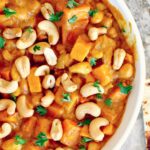
If you think green smoothies can’t get any healthier, try this drink with added wheatgrass juice. It’s healthy and nutritious for your body to take on any day.
Green Fruit Smoothie With Wheatgrass Juice [Vegan]
Ingredients You Need for Green Fruit Smoothie With Wheatgrass Juice [Vegan]
- 1/2 cup wheatgrass juice
- 1/2 cup filtered water
- 1 bunch romaine lettuce, chopped
- 2 bananas, thickly sliced and frozen
- 1 cup strawberries, cut in half (frozen or fresh)
- 1-2 pitted dates, chopped, if desired
How to Prepare Green Fruit Smoothie With Wheatgrass Juice [Vegan]
- Place ingredients in Vitamix in the order shown.
- Start on Variable speed 1 and slowly dial to 10, then flip to High.
- Process for about 30 seconds.
- Pour into glasses and serve.
Notes


![Green Fruit Smoothie With Wheatgrass Juice [Vegan] – One Green Planet](https://top-100-recipes.com/wp-content/uploads/2025/02/Green-Smoothie-With-Wheat-Grass-Juice-860x747.jpg)
![Cherry Chocolate Pie [Vegan] – One Green Planet](https://top-100-recipes.com/wp-content/uploads/2025/02/cherry-chocolate-pie1-150x150.jpg)



![Pull Apart Christmas Tree [Vegan] – One Green Planet](https://top-100-recipes.com/wp-content/uploads/2025/12/xscreen-shot-2019-11-29-at-1-57-39-pm-150x150.png.pagespeed.ic.9pB2mNa6N_.jpg)

